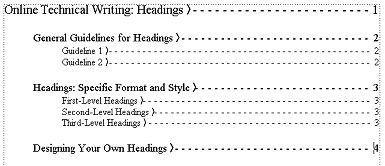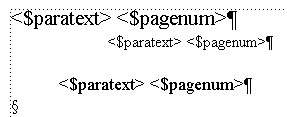FrameMaker 7.0 Tutorial: Tables of Contents
Introduction
A table of contents can be generated from either a single document or a book. The document or book from which the table of contents is generated is called the source document. For this tutorial, the source document has already been created for you.
Downloading and Saving the Source Document
To download the source document:
- Select the following link: contents.mif.
Note: Earlier versions of Netscape may attempt to display this file directly. To force Netscape to download this file, right-click the link above, and select Save Link Target As. - Select the directory in which to save the file, and click Save.
Note: If you are working in the TCM computer lab, save the file to your lab account. If you do not have a lab account, please contact your instructor.
To save the source document:
- Open FrameMaker, and select File > Open.
- Change to the directory in which you saved the source document.
- Select index.fm, and click Open. (If messages appear, click OK to continue.)
- Select File > Save As.
- Select the directory in which to save the file.
- In the File name box, change .mif to .fm.
- Click Save.
Applying Paragraph Tags
Tables of contents are based on the logical hierarchy of headings within a document. However, the text in your document is still all body text. Therefore, you will need to apply some paragraph tags to create headings.
To apply paragraph tags:
- Clicking
 (Paragraph Catalog) located in the top-right corner of the document window.
(Paragraph Catalog) located in the top-right corner of the document window.
- Place your cursor within the first paragraph, and then select Title from the Paragraph Catalog.
- Place your cursor within the “General Guidelines for Headings” paragraph, and select Heading1 from the Paragraph Catalog.
- Scroll down, and place your cursor within the “Guideline 1” paragraph.
- Select Heading2 from the Paragraph Catalog. (Select this format for the “Guideline 2” paragraph as well.)
- Place your cursor within the “Headings: Specific Format and Style” paragraph, and select Heading1.
- Select Heading2 for the following paragraphs:
- First-Level Headings
- Second-Level Headings
- Third-Level Headings
- Select Heading1 for the “Designing Your Own Headings” paragraph.
- Close the Paragraph Catalog dialog box, and save your document.
Generating the Table of Contents
In this section, you will learn how to generate a table of contents (TOC) for a single document.
To generate a table of contents:
- Select Special > Table of Contents, and click Yes to create a standalone Table of Contents for this document.
The Set Up Table of Contents dialog box appears.

By default, the Heading 1 and Heading 2 paragraph tags are included in the Include Paragraphs Tagged list.
- From the Don’t Include list, select Title, and click the left arrow.
- Click Set.
A new file containing the table of contents appears. Framemaker names this file using the name of the source document plus the suffix “TOC.”
| Note: As stated in the Introduction, you can generate a table of contents for a book as well; however, the instructions are different. |
Formatting the Table of Contents
To make your table of contents more readable, you must format the contents. This section discusses procedures necessary to format your table of contents.
This section discusses the following topics:
- Changing Paragraph Formats and Fonts
- Adding Tabs and Tab Leaders
- Modifying the TOC Reference Page
- Inserting a Title
Changing Paragraph Formats and Fonts
To change paragraph formats in the TOC:
- Open the Paragraph Designer (Ctrl + M).
- Place your cursor in the first paragraph.
This paragraph is called TitleTOC and contains the text “Online Technical Writing: Headings 1.”
- In the Paragraph Designer, click the Default Fault tab.
- Change the Size to 16 pt, and then click Update All.
- Place your cursor in the second paragraph.
This paragraph is called Heading1TOC and contains the text “General Guidelines for Headings 2.”
- In the Default Font properties box, change the Size to 14 pt, and then click Update All.
All Heading1TOC paragraph tags change to 14 pt.
- Click the Basic tab, and select 1 Line (17.0 pt) from the Space Above Pgf pull-down menu.
- Within the Indents area, type 0.5 in the First box, and then type 0.5 in the Left box.
- Click Update All.
- Place your cursor in the third paragraph. (This paragraph is called Heading2TOC and contains the text “Guideline 1 2.”)
- Within the Indents area, type 1.0 in the First box, and then type 1.0 in the Left box.
- Click Update All, and save your document.
Adding Tabs and Tab Leaders
To add a tab stop and tab leader:
- Place your cursor in the first paragraph (TitleTOC).
- Insert a right tab and leader:
- Within the Paragraph Catalog, click Edit located below the Tab Stops area on the Basic tab.
- In the New Position box, type 6.5.
- Within the Alignment area, select the Right radio button.
- Within the Leader area, select a leader style.
- Click Continue, and then click Update All.
- Repeat the steps above to add a right tab to the Heading1TOC and Heading2TOC paragraph formats.
- Close the Paragraph Designer dialog box.
- Make sure the tab symbols are visible (select View > Text Symbols), and place your cursor in the first paragraph between the word “Headings” and the page number “1.”
- Press the Tab key.
The page numbers should be right-aligned preceded by a dot leader.
- Repeat the steps above to insert a tab between the remaining paragraphs.
Your table of contents should look similar to the following.

| Note: These changes affect the paragraph tags and are now part of this document file. Whenever you update the table of contents, it will retain its formatting. However, the tab symbols that you typed between the text and the page number are not part of the paragraph tag. If you want FrameMaker to automatically insert your tab symbols after a TOC update, you must modify the reference page. |
Modifying the TOC Reference Page
To modify the TOC reference page:
- Select View > Reference Pages.
- Scroll down to the TOC reference page. (The title of the reference page appears in the FrameMaker scroll bar.)

The reference page should look similar to the following.

- Place your cursor in the first paragraph between the <$paratext> and the <$pagenum> building blocks.
This paragraph should be TitleTOC.
- Delete the space between the building blocks, and press the Tab key.
- Repeat the steps above for Heading1TOC and Heading2TOC.
- Select View > Body Pages to return to the body pages, and then save your document.
Inserting a Title
To insert a title for the table of contents:
- Place your cursor at the very beginning of the first paragraph. (Press the Home key to ensure you are at the beginning.)
- Type the word CONTENTS, and press Enter.
- Return to the line you just typed, and place your cursor anywhere in this paragraph.
- Apply the paragraph tag Title to this paragraph, and save your document.
Updating the Table of Contents
As your document changes, you must update your table of contents so that it remains current.
To update the table of contents:
- Select Window > contents.fm to return to the source document.
- Scroll to the first paragraph and place your cursor immediately before the word “Headings,” and then type The Importance of.
- Select Special > Table of Contents, and click Yes when asked “Do you want to create a standalone Table of Contents in this document?”
- In the Set Up Table of Contents dialog box, click Set.
FrameMaker updates your table of contents to reflect the change.
In this tutorial, you learned how to generate a table of contents, customize the formatting of the contents page, and update the table of contents.


Comments